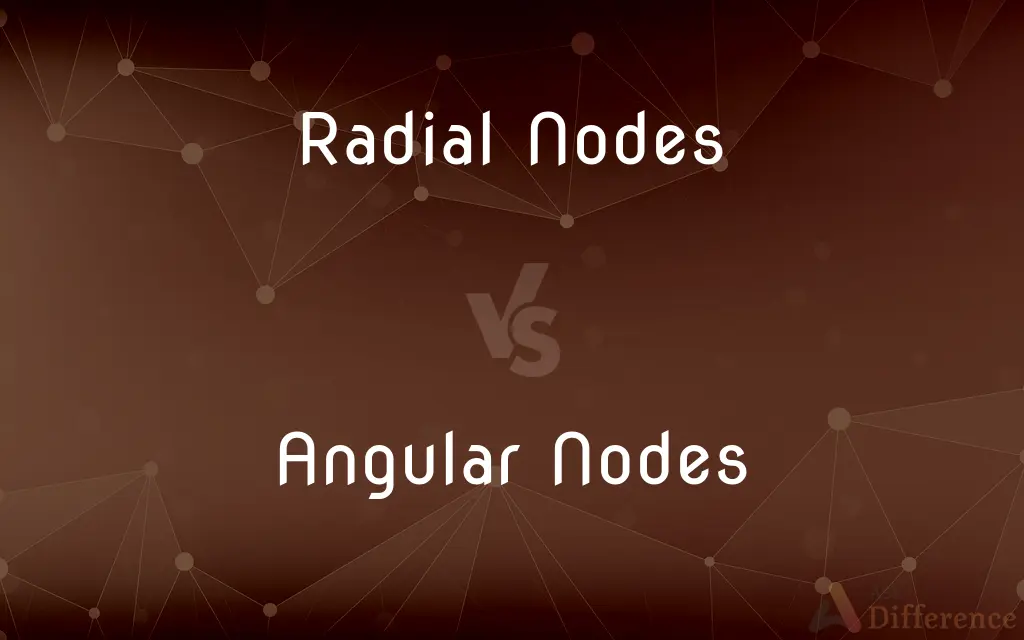Radial Nodes vs. Angular Nodes — What's the Difference?
By Tayyaba Rehman — Published on December 30, 2023
Radial Nodes are regions where the probability of finding an electron is zero at a certain distance from the nucleus, while Angular Nodes relate to specific angles or directions from the nucleus with zero electron probability.

Difference Between Radial Nodes and Angular Nodes
Table of Contents
ADVERTISEMENT
Key Differences
Radial Nodes pertain to the electron probability distribution in atoms, specifically the areas where this probability becomes zero based on the distance from the nucleus. In essence, they represent spherical shells around the nucleus where the likelihood of encountering an electron is nil.
Conversely, Angular Nodes are tied to specific angles or directional planes around the nucleus. They highlight regions in which the probability of discovering an electron is zero due to the atom's spatial orientation. Angular Nodes can create various shapes, such as planes or cones, contingent upon the atomic orbital in question.
While both Radial Nodes and Angular Nodes represent areas of zero electron probability, their defining distinction lies in their spatial relationship to the atomic nucleus. The former is based solely on the radial distance from the nucleus, whereas the latter concerns specific angular orientations.
Electron behavior within atomic orbitals can be complex. Radial Nodes and Angular Nodes serve as aids in visualizing and understanding the areas within these orbitals where electrons are unlikely to be found. Despite both referring to regions of zero electron probability, their conceptual difference, based on radial versus angular positioning, is crucial in quantum mechanics.
In sum, while both Radial Nodes and Angular Nodes delineate zones in an atom where electrons aren't typically present, their differentiation is rooted in their spatial definitions relative to the nucleus—distance for Radial Nodes and direction for Angular Nodes.
ADVERTISEMENT
Comparison Chart
Definition
Regions of zero electron probability based on distance from the nucleus.
Regions of zero electron probability due to specific angles or directions from the nucleus.
Shapes Produced
Spherical shells around the nucleus.
Planes or cones contingent upon the atomic orbital.
Associated with
Radial distance from the nucleus.
Angular orientations around the nucleus.
Determined by
Principal quantum number (n) and azimuthal quantum number (l).
Solely by the azimuthal quantum number (l).
Example Atomic Orbital Presence
Found in all types of orbitals depending on the quantum numbers.
Absent in s orbitals, present in p, d, and f orbitals.
Compare with Definitions
Radial Nodes
Radial Nodes are spherical regions in atomic orbitals where electron presence is improbable.
In certain atomic orbitals, Radial Nodes manifest as concentric spheres with no electron probability.
Angular Nodes
Angular Nodes are absent in s orbitals but present in p, d, and f orbitals.
S orbitals are spherical with no Angular Nodes, while p orbitals have one nodal plane each.
Radial Nodes
Radial Nodes denote points of phase change in wave functions.
At Radial Nodes, the wave function of the electron changes its phase.
Angular Nodes
Angular Nodes create distinct shapes within atomic orbitals.
The presence of Angular Nodes is why d orbitals have more complex shapes than p orbitals.
Radial Nodes
Radial Nodes arise from the interaction of different wave phases in orbitals.
Radial Nodes emerge when waves within atomic orbitals interfere destructively.
Angular Nodes
Angular Nodes define regions of electron wave phase changes based on angle.
Angular Nodes indicate where electron wave functions transition between positive and negative phases based on direction.
Radial Nodes
Radial Nodes are characterized by their radial distance from an atom's nucleus.
As you move outward from the nucleus, you'll encounter specific distances marked by Radial Nodes.
Angular Nodes
Angular Nodes are determined by the orbital's azimuthal quantum number.
Each increment in the azimuthal quantum number introduces an additional Angular Node.
Radial Nodes
Radial Nodes increase with higher energy atomic orbitals.
Higher energy orbitals tend to have more Radial Nodes than their lower energy counterparts.
Angular Nodes
Angular Nodes represent planes or regions where there's zero probability of finding an electron based on direction.
Angular Nodes in p orbitals result in a dumbbell shape due to the nodal plane.
Common Curiosities
Are there atomic orbitals without any nodes?
Yes, the 1s orbital has no Radial or Angular Nodes.
What's the main difference between Radial Nodes and Angular Nodes?
Radial Nodes are based on distance from the nucleus, while Angular Nodes are based on specific angles or directions from the nucleus.
Why are there no Angular Nodes in s orbitals?
s orbitals are spherically symmetric, so there's no directional preference, leading to no Angular Nodes.
What causes nodes in atomic orbitals?
Nodes arise from the destructive interference of electron waves.
How do Angular Nodes influence chemical bonding?
Angular Nodes can affect overlap and therefore the type and strength of bonds atoms can form.
How are Radial Nodes determined?
They are determined by both the principal and azimuthal quantum numbers.
Can you visually represent both types of nodes?
Yes, Radial Nodes appear as concentric spherical shells, whereas Angular Nodes manifest as planes or cones in atomic orbitals.
Do Radial Nodes affect the shape of atomic orbitals?
While they affect electron distribution, the distinctive shapes of orbitals are more influenced by Angular Nodes.
Are nodes only theoretical, or can they be observed?
While nodes arise from quantum mechanical descriptions, their effects can be observed in experiments like electron diffraction.
Can an orbital have both types of nodes?
Absolutely, higher energy orbitals often have multiple Radial and Angular Nodes.
Can there be more than one Radial Node in an orbital?
Yes, the number of Radial Nodes increases with the energy of the orbital.
How does the azimuthal quantum number relate to Angular Nodes?
The azimuthal quantum number (l) determines the number of Angular Nodes, which equals l.
Do all atomic orbitals have Radial Nodes?
No, some lower energy orbitals lack Radial Nodes, but they can increase with higher energy levels.
Share Your Discovery

Previous Comparison
Options vs. Possibilities
Next Comparison
Glucogenic Amino Acids vs. Ketogenic Amino AcidsAuthor Spotlight
Written by
Tayyaba RehmanTayyaba Rehman is a distinguished writer, currently serving as a primary contributor to askdifference.com. As a researcher in semantics and etymology, Tayyaba's passion for the complexity of languages and their distinctions has found a perfect home on the platform. Tayyaba delves into the intricacies of language, distinguishing between commonly confused words and phrases, thereby providing clarity for readers worldwide.














































